Gerardo Mosquera
Gerardo Mosquera (born 1945 in Havana, Cuba) is a freelance curator, critic, art historian, and writer based in Havana, Cuba. He was one of the organizers of the first Havana Biennial in 1984 and remained central to the curatorial team until he resigned in 1989. Since then, his activity turned to be mainly international: he has been traveling, lecturing and curating exhibitions in more than 80 countries. Mosquera was adjunct curator at the New Museum of Contemporary Art, New York, from 1995 to 2009. Since 1995 he is advisor in the Rijksakademie van Beeldende Kusten in Amsterdam. His publications include several books on art and art theory (and a short stories' volume), and more than 600 articles, reviews and essays have appeared in numerous magazines, including: Art Nexus, Cahiers, Lápiz, Neue Bildende Kunst, Oxford Art Journal, Poliester, Third Text. Among other volumes, Mosquera has edited Beyond the Fantastic: Contemporary Art Criticism from Latin America and co-edited (with Jean Fisher) Over Here: International Perspectives on Art and Culture. His theoretical essays – which have been influential in discussing art’s cultural dynamics in an internationalized world, and contemporary Latin American art – are dispersed in English, but have been collected in books in Caracas[1] and Madrid[2] in Spanish, and in Chinese in Beijing.[3] Mosquera was the Artistic Director of PHotoEspaña, Madrid (2011–2013), the Chief Curator of the 4th Poly/Graphic San Juan Triennial(2015-2016), and co-curator of the 3rd Documents, Beijing (2016).
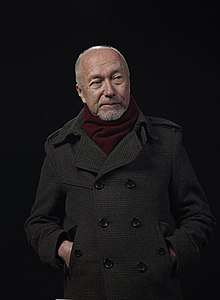
Early work
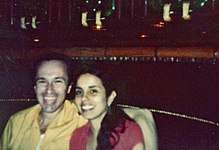
Mosquera obtained his licenciatura in History of Art at the University of Havana in 1977. Since the early 1970s he was working as art, cinema and theater critic, researcher and journalist in Havana. He published thorough investigations on Servando Cabrera Moreno and Manuel Mendive[4] two Cuban artists who had previously been marginalized for the erotic and religious Afro-Cuban (Mendive) content of their art, and as a result of homophobic cultural policies. Mosquera became the main critic and “ideologist” of the new Cuban art,[5][6] which he supported since its inception. In the 1980s this movement renovated the Cuban art scene, breaking away from official dogmatism and introducing contemporary critical tendencies. It was successful in pushing the Ministry of Culture to open up towards a more liberal cultural policy. Mosquera’s critical writings on the new Cuban art were instrumental to this turn, while he also promoted the new artists internationally.[7] This movement triggered a critical and reflexive inclination that distinguishes Cuba’s arts until today. Mosquera’s work has also always looked beyond Cuba, as can be seen in his book El diseño se definió en Octubre (Design was Defined in October),[8] about Russian avant-garde art and design and its worldly impact, published in Havana in 1989 and Bogotá in 1992.
Havana Biennial
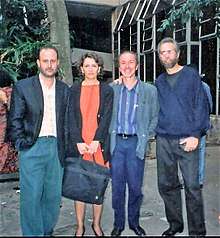
The first Havana Biennial took place in 1984. It became the fourth international biennial (after Venice, São Paulo and Sydney) and the sixth huge international periodic art event to be established —following the aforementioned biennials, the Carnegie International and Documenta. Supported by the Cuban government, it was a vast show, but restricted to Latin America. In 1986 the 2nd Havana Biennial presented the first global show of contemporary art ever: more than 50 exhibitions and events that gathered 690 artists from 57 countries focusing on postcolonial contemporary art and not on traditional and religious practices. The next Biennial edition, in 1989, introduced radical curatorial changes that moved it away from the Venice and São Paulo paradigms, launching a new model that influenced the way in which the new biennials were organized. Transformations included basing the whole event (shows, conferences, workshops, etc.) on a general theme, the combination of a centralized curation that avoided national representations with a decentralized structure involving a constellation of multiple events, the link with the city, and the eradication of awards. Recently, it has become clear that it was the Havana Biennial and not Les magiciens de la terre –an exhibition that was advertised as “the first global show”—, that was initiating the way in which globalization will take shape in art, triggering “a new breed of contemporary biennials born of a global context” (Istanbul, Johannesburg, Gwangju, Lyon, etc.).[9] The Havana Biennial approached for the first time the multiple practices of contemporary art around the world, out of the Western mainstream. Since 1984, Mosquera was Havana Biennial's "leader of the curatorial work",[10] reformulating the premise and methodology of the event, with which his “own aesthetic and intellectual interests became deeply embedded.”[11] He resigned in 1989, immediately after the 3rd Biennial, due to the escalating repression in the cultural sector, and to political contradictions with the Cuban regimen and about the Biennial’s future.[12]
International work
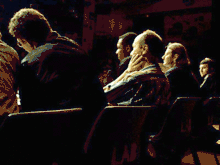
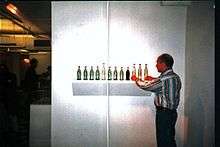
After his resignation to the Havana Biennial, Mosquera was banned to publish, curate and lecture in his country until today, and since then he has been working as a freelance internationally. In 1990 he was a Guggenheim Fellow. From 1995 to 2009 he was adjunct Curator at the New Museum of Contemporary Art, New York, although his work was seriously hampered by legal constraints due to the United States embargo against Cuba, where he continued to live. Together with Dan Cameron he set off a program at the Museum that introduced a broader international approach in the New York art scene. His radical notion of “the museum-as-hub”[13] transformed the New Museum’s Education Department to include what is called the Museum as Hub, “a new model for curatorial practice and institutional collaboration established to enhance our understanding of contemporary art. Both a network of relationships and an actual physical site…”[14] with an international program of its own. Mosquera's theoretical work pioneered critical discussions about the complex cultural processes of modern and contemporary art from non-mainstream countries, especially in relation to mainstream art, globalization and postcolonial dynamics.[15] He has also contributed to promote an open, multifaceted view on Latin American art, moving away from the identity stereotypes that prevailed in the 1980s[16] – his standings being sometimes polemical.[17] The exhibition Ante America, which he co-curated in 1992 (see below), was a landmark for this new view on Latin American art. Mosquera’s ideas, position and curatorial and editorial practice have been significant in the new scenario of broad international circulation of art.[18][19] He introduced the notion of "from here" to oppose the “appropriation” paradigms – such as the Brazilian idea of “anthropophagy” – that prevailed to discuss postcolonial art’s strategies, conferring it an active role in the construction of global metaculture.[20] The curator's work has lately focused on projects out of the white cube, trying to achieve artistic communication with broader audiences, beyond the art world’s elite.[21] Some examples are his contribution to the Liverpool Biennial, and shows that have tried to create an active dialogue with the public space and to involve people in the streets, as CiudadMultipleCity. Arte>Panamá 2003 (), The Sky Within My House, Contemporary Art in Patios of Quito (), and ¡Afuera! (see all below).
Main curatorial work
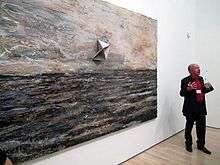
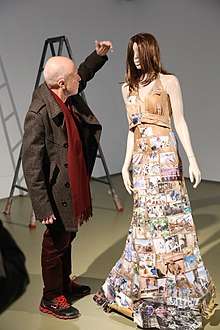
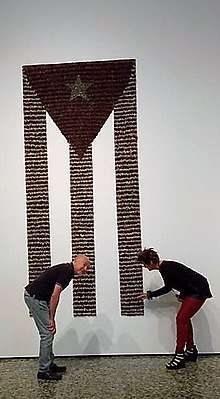
Useless: Machines for Dreaming, Thinking and Seeing., Bronx Art Museum, March 27, 2019 to September 1, 2019
Adiós Utopia. Dreams and Deceptions in Cuban Art Since 1950, The Museum of Fine Arts, Houston, Texas, USA, March 3, 2017 (with René Francisco Rodríguez and Elsa Vega), Walker Art Center, Nov 11, 2017–Mar 18, 2018
BRIC-à-brac. The Jumble of Growth, Today Art Museum, Beijing, December 10, 2016 (with Huang Du).
Vida. Gervasio Sánchez, CEART Fuenlabrada, Madrid, Spain, December–March, 2016; Afundación, Santiago de Compostela, October 2017-January 2018; Sala de Exposiciones de la Diputación de Huesca, Huesca, March–May 2018; Afundación, A Coruña, June–September 2018.
Cristina Lucas. Iluminaciones profanadas, Museo de Arte Contemporáneo de Puerto Rico, Santurce, San Juan, November 18, 2016.
Fernando Sánchez Castillo. Hoy fue también un día soleado, Sala de Arte Público Siqueiros, Mexico City, June 7, 2016.
4th Poly/Graphic San Juan Triennial: Latin American and the Caribbean, Displaced Images / Images in Space, Antiguo Arsenal de la Marina Española, Old San Juan; Casa Blanca; Cagas Art Museum; Museum of Art of Puerto Rico; Museum of Art and History of San Juan; Museum and Center for Humanistic Studies Dr. Josefina Camacho Camacho de la Nuez, Turabo University; Museum of History, Anthropology and Art, UPR Río Piedras; Ponce Art Museum; Puerto Rico Museum of Contemporary Art; Puerto Rico, October 24, 2015 to February 28, 2016 (with Alexia Tala and Vanessa Hernández Gracia).
Perduti nel Paesaggio / Lost in Landscape, Museo di arte moderna e contemporánea di Trento e Rovereto, April 4, 2014.
Artificial Amsterdam. The City as Artwork, de Appel, Amsterdam, June 28, 2013.
Manuel Álvarez Bravo. Un photographe aux aguets, Jeu de Paume, Paris, October 15, 2012; Fundación MAPFRE, Madrid, February 12, 2013; Museo Amparo, Puebla, June 2013 (with Laura González Flores).
Here We Are. Richard Avedon, Richard Billingham, Paz Errázuriz, Lilla Szász, Círculo de Bellas Artes, Madrid, June 7, 2011 (with Mónica Portillo).
Face to Time, Real Jardín Botánico, PHotoEspaña, Madrid, June 1, 2011.
Ron Galella. Paparazzo Extraordinaire, Círculo de Bellas Artes and Loewe Gran Vía, PHotoEspaña, Madrid, June 1, 2011; Einladung, Berlin, December 9, 2011; FOAM, Amsterdam, June 7, 2012; Centro Sociocultural Novacaixagalicia, A Corunha, October 3, 2013; Galería Fundación Novacaixagalicia, Vigo, January 23, 2014.
Face Contact, Centro de Arte Teatro Fernán Gómez, PHotoEspaña, Madrid, May 31, 2011; Iberia Center for Contemporary Art, Beijing, April 28, 2012.
1000 Faces / 0 Faces / 1 Face. Cindy Sherman, Thomas Ruff, Frank Montero, Sala Alcalá 31, PHotoEspaña, Madrid, May 30, 2011.
Fayum Portraits + Adrian Paci. No Visible Future, Museo Arqueológico, PHotoEspaña, Madrid, May 30, 2011.
crisisss. Latin America, Art and Confrontation. 1910–2010, Palacio de Bellas Artes and ExTeresa Arte Actual, Mexico City, March 12, 2011.
¡Afuera! Arte en espacios públicos, Córdoba, Argentina, October 8, 2010 (with Rodrigo Alonso).
Arte contemporáneo y patios de Quito, September 4, 2010.
Denarrations, PanAmerican Art Projects, Miami, November 14, 2009.
The Sky Within my House. Contemporary Art in 16 Patios of Cordoba. October 22, 2009.
7 + 1 Project Rooms, Museo de Arte Contemporáneo de Vigo, October 10, 2008.
States of Exchange. Artists from Cuba, INIVA, London, January 22, 2008 (with Cylena Simonds).
Border Jam, Regional Encounter of Art 2007, Montevideo. Museo Nacional de Artes Visuales, Museo Municipal Juan Manuel Blanes, Centro Cultural de España, Museo y Archivo Histórico Municipal (Cabildo), public realm, August 9, 2007.
Transpacific. An Encounter in Santiago, La Moneda Palace Cultural Center, Santiago, Chile, May 17, 2007.
Liverpool Biennial International 06, September 16, 2006 (with Manray Hsu).
Cordially Invited, BAK and Central Museum, Utrecht, October 30 to December 31, 2004 (with Maria Hlavajova).
Panorama of Brazilian Art 2003 (Desarrumado). 19 Disarrangements, Museum of Modern Art, São Paulo, October 16 to November 30, 2003; Paço Imperial, Rio de Janeiro, December 16, 2003 to February 2004; Museum of Modern Art Aloísio Magalhaes, Recife, March 11 to May 6, 2004; MARCO, Museo de Arte Contemporáneo de Vigo, January to May, 2005; Museo de Arte del Banco de la República de Colombia, Bogotá, November 2008 to February 9, 2009.
CiudadMultipleCity. Arte>Panamá 2003 (International Urban Art Event) March 20 – April 20, 2003 (with Adrienne Samos)
It’s Not What You See. Perverting Minimalism, Centro de Arte Reina Sofía, Madrid, December 12, 2000 to February 19, 2001
Cinco continentes y una ciudad. III Salón Internacional de Pintura, Museo de la Ciudad de México, August, 2000
Absent Territories, Casa de América, Madrid, January 28 to March 26, 2000
Cildo Meireles, New Museum of Contemporary Art, New York, November 18, 1999 to March 15, 2000; MOMA São Paulo, July 15 to August 20, 2000; MOMA Río de Janeiro, October 5 to December 2, 2000 (with Dan Cameron)
Cinco continentes y una ciudad. I Salón Internacional de Pintura, Museo de la Ciudad de México, November, 1998
Important and Exportant, 2nd Johannesburg Biennale, Johannesburg Art Gallery, October 12, 1997 to January 12, 1998
Enclosures, The New Museum of Contemporary Art, New York, November 24, 1996 to January 26, 1997 (with Dan Cameron)
Wifredo Lam, 23rd Sâo Paulo Biennial, October–December, 1997
Ante América, Biblioteca Luis Ángel Arango, Bogotá, October 27 to December 20, 1992; Museo Alejandro Otero, Caracas, March 14, 1993; Queens Museum, New York, July 15 to September 26, 1993; Centro Cultural de la Raza, San Diego, October 16 to November 21, 1993; Yerbabuena Center for the Arts, San Francisco, January 30, 1994; Spencer Museum, University of Kansas, Lawrence, March to May 15, 1994; Museo de Arte y Diseño Contemporáneo, San José, August 24 to October 30, 1994 (with Carolina Ponce de León and Rachel Weiss)
América: Cambio de Foco, Biblioteca Luis Ángel Arango, Bogotá, October 19, 1992; Cámara de Comercio, Medellín, May 6, 1993 (with Carolina Ponce de León and Rachel Weiss)
Los Hijos de Guillermo Tell. Artistas Cubanos Contemporáneos, Museo Alejandro Otero, Caracas, February–March 1991; Biblioteca Luis Angel Arango, Bogotá, April 4 to May 17, 1991 (with Graciela Pantin)
The Nearest Edge of the World. Art and Cuba Now, Massachusetts College of Art Main Gallery, Boston, November 7 to December 5, 1990; The Bronx Museum Of Art, New York, 1991; University of the South, Sewanee, 1991; Anderson Gallery, Virginia Commonwealth University, Richmond, 1991; The School of the Art Institute of Chicago, 1992; CU Art Galleries, Colorado University, Boulder; Southeastern Center for Contemporary Art, SECCA, Winston-Salem, 1993; Mexico Arte, Austin, 1993; Nexus Contemporary Art Center, Atlanta, 1994; Art Shows International, Sarasota, 1994 (with Rachel Weiss)
3rd Havana Biennial, Centro Wifredo Lam, 1989
African Wire Toys, 3rd Havana Biennial, Museo de Artes Decorativas, Havana, November 1 to December 31, 1989
Raíces en Acción. Nuevos Artistas de Cuba, Museo Carrillo Gil, Mexico D. F., November 10, 1988; Museo Biblioteca Pape, Coahuila, January to March, 1989
Africa Inside Cuba: 3 Artists, Kinshasa and Maputo, 1988
Tres Artistas Cubanos. Minerva Cuevas, Wifredo Lam, Ricardo Rodríguez Brey, Museo Nacional de Kinshasa, 7 al 12 de agosto de 1987
Modern Makonde Sculpture, Centro Provincial de Artes Plásticas y Diseño, Havana, May 22, 1987
2nd Havana Biennial, Centro Wifredo Lam, November, 1986
Africa Inside Cuba: 6 Artists, Museo Nacional de Antropología de Angola, Luanda, April–May, 1986; Núcleo de Arte, Maputo, 1986; Centro Wifredo Lam, Havana, May–June, 1986
1st Havana Biennial, Centro Wifredo Lam, 1984
Jóvenes Artistas. Retrospectiva, Galería Lalo Carrasco, Hotel Habana Libre, Havana, October, 1981 (with Flavio Garciandía and José Veigas)
Manuel Mendive: un Pintor de lo Real Maravilloso, Galería L, Havana, 1981
Obras Inéditas de Servando Cabrera Moreno, Galería L, Havana, September, 1979
Books
Arte desde América Latina (y otros pulsos globales), Ediciones Cátedra, Madrid, 2020.
“Un gran tiempo de híbridos”, Híbridos. El cuerpo como imaginario, Museo del Palacio de Bellas Artes, Ciudad de México, 2018, p. 341-356.
“crisisss. Arte y confrontación en América Latina. Gerardo Mosquera. México DF, México, 2011”, Juan José Santos Mateo: Curaduría de Latinoamérica. 20 entrevistas a quienes cambiaron el arte contemporáneo, CENDEAC, Murcia, 2018, p. 323-337.
“Arte y utopía. 1970 a 1990: dos décadas en guerra” and “Tania Bruguera. Artivismo y represión en Cuba. Informe de un testigo presencial”, Andrés Isaac Santana (editor): Lenguaje sucio. Narraciones críticas sobre el arte cubano Tomo I y II, Editorial Hypermedia, 2019, p. 33-43 y 487-492.
"Historia, tiempo, violencia”. Longitud de onda. Cristina Lucas. Turner, Madrid, 2017, p. 51-61.
“La Geo-Política del Arte Contemporáneo" (Co-editor & co-author with Nikos Papastergiadis). ERRATA#14. Geopolíticas del Arte Contemporáneo. July–December, 2015, pp. 18–38.
“Tong”. Magdalena Atria. Consejo Nacional de la Cultura y las Artes, Pontificia Universidad Católica de Chile, Galería XS, Santiago de Chile, 2015, pp. 60–71, 168-171.
“Gentlemen of Transgression”. Daniele Tamagni: Fashion Tribes. Global Street Style. New York: Abrams, 2015, p. 196-199.
"Gentlemen of Transgression”. Daniel Tamagni: Global Style Battles. Identités et sud cultures urbaines. Paris: Éditions La Découverte, 2015, pp. 196–199.
"Prólogo”. John A. Loomis: Una revolución de formas. Las olvidadas escuelas de arte de Cuba. Barcelona: dpr, 2015, pp. 21–23.
“Além da antropofagia: arte, internacionalização e dinâmica cultural”. Histórias Mestiças. Antologia de textos (organized by Adriano Pedrosa and Lilia). Río de Janeiro: Cobogó, 2014, pp. 328–338.
“El arte en tiempos híbridos”. Visiting Minds 2013. Pedagogía radical: El arte como educación. Panamá: Sarigua, 2015, pp. 192–200; 214-221.
“René Portocarrero”. Todo sobre Portocarrero. Compilación de textos críticos 1936-2010 (compiled by Ramón Vázquez Díaz, Axel Li, José Veigas). Havana: Fundación Arte Cubano, 2014, pp. 307–316.
Infinite Islands. Art, Culture, Internationalization. Beijing: BeePub, 2014.
Adriano Pedrosa; Luisa Duarte (editors): ABC - Arte brasileira contemporânea (curator & contributor). São Paulo: Cosac Naify, 2013, pp. 384–385.
“La Biennale de La Havane : une utopie concrète”. Sophie Orlando, Catherine Grenier (editors): Art et mondialisation. Anthologie de textes de 1950 à nos jours. Paris: Centre Pompidou, 2013, pp. 229–234.
“Jatibonico. Notas sobre migración y dinámica cultural”; “Diálogo entre Gerardo Mosquera y José Manuel Springer”. José Manuel Springer (coordinator): Migraciones: territories y fronteras. Desplazamientos culturales y nomadismo artístico. Valencia: Editorial Universidad Politécnica de Valencia, 2012, pp. 31–39;71-79.
“Beyond Anthropophagy: Art, Internationalization, and Cultural Dynamics”: Hans Belting, Andrea Buddensieg y Peter Weibel (editors): The Global Contemporary and the Rise of New Art Worlds (contributor). Karlsruhe, Cambridge (MA) and London: Center for Art and Media and The MIT Press, 2013, pp. 233–238.
“Virginia Pérez-Ratton”. Víctor Hugo Acuña Ortega, Alexandra Ortiz Wallner, Dominique Ratton Pérez (editors): Virginia Pérez-Ratton. Travesía por un estrecho dudoso. San José: TEOR/éTICA, 2012, pp. 267–268.
“Arte y nuevos públicos, ¿una aporía?”. Negociaciones: Puentes estratégicos entre el arte y los públicos. Honduras, Panama: CAVC/MUA, Fundación Arte>Panamá, 2012, pp. 27–29.
“Facing the Americas”; “From Latin American Art to Art from Latin America”. Héctor Olea, Mari Carmen Ramírez, Tomás Ybarra-Frausto (organizers): Resisting Categories: Latin American and / or Latino? Critical Documents of 20th Century Latin American and Latino Art. New Haven and London: The Museum of Fine Arts, International Center for the Arts of the Americas, Houston, Yale University Press, 2012, pp. 1068–1076; 1123-1132.
Desde aquí. Contexto e internacionalización (contributor & editor). Madrid, PHotoEspaña, 2012, www.phe.es.
“Del arte latinoamericano al arte desde América Latina”. Adriano Pedrosa (editor): Art Nexus. Brasil en Colombia. Antología de textos. Bogotá: Arte en Colombia, 2011, pp. 164–168.
“Luis González Palma habla con Gerardo Mosquera”. Conversaciones con Fotógrafos / Conversations with Photographers (contributor). Madrid: La Fábrica, 2011.
“Retratos de Fayum + Adrian Paci. Sin futuro visible”. Jean-Christophe Bailly: La llamada muda. Ensayo sobre los retratos de El Fayum. Madrid: Akal, PHotoEspaña, Madrid, 2011, pp. III-V.
Interfaces. Retrato y comunicación (contributor & editor). Madrid: La Fábrica Editorial, PHotoEspaña, 2011, pp. 7–15.
“Más allá del ajiaco. Notas sobre lengua y cultura en el Caribe”. Utrópicos. Contexto. Pontevedra: XXXI Bienal de Pontevedra, 2010, pp. 49–55.
“The Havana Biennial: A Concrete Utopia”; “The Marco Polo Syndrome: Some Problems around Art and Eurocentrism”. Elena Filipovic, Mieke van Hal & Solveig ÿvsteb (editors): The Biennial Reader. An Anthology on Large-Scale Perennial Exhibitions of Contemporary Art, Bergen/Ostfildern, Bergen Kunsthall/Hatje Cantz Verlag, 2010, pp. 198–207; 416-425.
Caminar con el Diablo. Textos sobre arte, internacionalismo y culturas. Madrid: Exit Publicaciones, 2010.
“Against Latin American Art”. Contemporary Art in Latin America (contributor & advisor). London: Black Dog Publishers, 2010, pp. 11–23.
Rotterdam Dialogues. The Critics, The Curators, The Artists. Rotterdam: Witte de With & Posteditions, 2010, pp. 190–191.
“The New Cuban Art”. Ales Erjavec (editor): Postmodernism and the Post Socialist Condition. Politicized Art under Late Socialism. Beijing, 2009 (chinese), pp. 276–327.
“Walking with the Devil: Art, Culture and Internationalization”. Helmut Anheier & Yudhishthir Raj Isar (editors): Cultural Expression, Creativity & Innovation. London, Thousand Oaks, Nueva Delhi, Singapore: SAGE, 2010, pp. 47–56.
“Cuba in Tania Bruguera’s work: The body is the social body”. Tania Bruguera: On the political imaginary. Milano: Ed Charta, 2009, pp. 23–35.
“Jineteando al diablo. Arte contemporáneo, cultura y (des)extranjerización”. Néstor García Canclini (editor): Extranjeros en la tecnología y en la cultura. Buenos Aires: Ariel, Fundación Telefónica, pp. 51–63.
“La isla infinita: introducción al nuevo arte cubano”; “Arte preso. Ángel Delgado 1242900”; “Arte haciendo política. Eduardo Ponjuán y René Francisco”- Andrés Isaac Santana (editor): Nosotros, los más infieles. Narraciones críticas sobre el arte cubano (1993-2005). Murcia: CENDEAC, pp. 81–91; 314-317; 488-490.
“Todo lo que usted necesita es amor”. I Insulted Flavio Garciandía in Havana. Mexico City: Turner, 2009, pp. 291–305.
“Globalización, algunas disyuntivas culturales”. I Encuentro de Arquitectura Tropical. San José: Instituto de Arquitectura Tropical, 2008, pp. 97–107.
“Desde aquí: arte contemporáneo, cultura e internacionalización”. Javier Domínguez, Carlos Arturo Fernández, Efrén Giraldo, Daniel Jerónimo Tobón (editors): Moderno/contemporáneo: un debate de horizontes. Antioquia: La Carreta del Arte, Universidad de Antioquia, 2008, ps. 111-133.
“Esferas, ciudades, transiciones. Perspectivas internacionales del arte y la cultura”. Pedro de Llano (editor): Wrong Site. Arte y globalización. A Coruña: Fundación Luis Seoane, 2008, pp. 112–123.
“Nfinda mató a Versalles”. Marta Palau. Naualli. Mexico, D.F.: Turner, 2006, pp. 234–241.
Copying Eden. Recent Art in Chile. Santiago: Puro Chile, 2008 (booklet).
“Caminando con el Diablo”; “José Damasceno”; “Carlos Garaicoa”; “Jose Antonio Hernández-Diez”; “Wilfredo Prieto”; “Adriana Varejao”. Rosa Olivares (editor): 100 artistas latinoamericanos. Madrid: Exit, 2007, pp. 21–23; 134; 182; 214; 362; 422.
“The Urban Revolution”. Arjan van Helmond & Stani Michiels (editors): Jakarta Megalopolis. Horizontal and Vertical Observation. Amsterdam: Valiz, 2007, pp. 22–24.
“ciudadMULTIPLEcity. Art with the City: an Experiment in Context”. What’s Up, Biennale? The Internacional Symposium 2007. Busan: Busan Biennale, 2007, pp. 39–47 & DVD with Rich Pitter documentary.
“Seven Notes on the Museum-as-Hub”. Re-Shuffle/Notions of an Itinerant Museum. New York: Center for Curatorial Studies, Bard College, 2006.
“Arte con la ciudad”. Gerardo Mosquera, Adrienne Samos (editors): ciudadMULTIPLEcity. Arte>Panamá 2003. Urban Art and Global Cities: an Experiment in Context. Amsterdam: KIT Publishers, 2005, pp. 22–43.
“Renovación en los años 80”; “La plástica cubana en un nuevo siglo”; “Crece la yerba”; “Reporte del hombre en La Habana”; “Arte y cultura crítica en Cuba”. Magaly Espinosa y Kevin Power (editores): Antología de textos críticos: el nuevo arte cubano. Santa Mónica: Perceval Press, Santa Mónica, 2006, pp. 17–23; 59-61; 89-90; 141-146; 195-198.
Copiar el Edén. Arte reciente en Chile (editor & introduction). Santiago: Puro Chile Publishers, 2006.
“El nuevo arte cubano”. Pablo Oyarzún, Nelly Richard, Claudia Zaldívar (editors): Arte y política. Santiago de Chile: Universidad ARCIS, Facultad de Artes, Universidad de Chile, 2005, pp. 253–279.
"Interview with Cildo Meireles". pressPlay. Contemporary Artists in Conversation. London: Phaidon Press, 2005, pp. 462–475.
“Codo a codo. Conversación entre Gerardo Mosquera, Francis Alÿs, Rafael Ortega y Cuauhtémoc Medina”. Francis Alÿs, Cuauhtémoc Medina (editors): Cuando la fé mueve montañas. Madrid: Turner, Madrid, 2005, pp. 64–105.
Francis Alÿs: The Modern Procession (contributor). New York: Public Art Fund, 2004, p. 151.
Over Here. International Perspectives on Art and Culture (editor & introduction with Jean Fisher). New York, Cambridge, London: New Museum of Contemporary Art/The MIT Press, 2004.
“The Marco Polo Syndrome: Some Problems around Art and Eurocentrism”. Zoya Kocur and Simon Leung (editors): Theory in Contemporary Art since 1985. Malden, Oxford and Victoria: Blackwell Publishing, 2005, pp. 218–225.
“Modernism from Afro-America: Wifredo Lam”. Gilane Tawadros (editor): Changing States. Contemporary Art and Ideas in an Era of Globalisation. London: Institute of International Visual Arts, 2004, pp. 278–283.
“A Reproduction of Solitude”. Irene Kopelman: Documenting Three Interventions in a Space. Amsterdam: Rijksakademie van Beldende Kunsten, 2003. “The New Cuban Art”. Ales Erjavec (editor): Postmodernism and the Postsocialist Condition. Politicized Art under Late Socialism. Los Angeles/Berkeley/London: University of California Press, 2003, pp. 208–246.
“Global Islands”; “From”. Okwui Enwezor, Carlos Basualdo, Ute Meta Bauer, Susanne Ghez, Sarat Maharaj, Mark Nash and Octavio Zaya (editors): Crèolitè and Creolization, Documenta 11_Platform3. Ostfildern-Ruit: Museum Fridericianum; Hatje Cantz Publishers, 2003, pp. 87–92, 145-148.
“El arte latinoamericano deja de serlo”. Víctor Manuel Rodríguez (editor): Prácticas artísticas, enfoques contemporáneos. Bogotá: Universidad Nacional de Colombia, 2003 pp. 35–47.
“Alien-Own/Own-Alien. Notes on Globalisation and Cultural Difference”. Nikos Papastergiadis (editor): Complex Entanglements. Art, Globalisation and Cultural Difference. London: Rivers Oram Press, 2003, pp. 18–29.
“Seis nuevos pintores”; “Volumen uno”; “Nuevos artistas”; “Renovación en los años ochenta”; “Feminismo en Cuba”; “Los catorce hijos de Guillermo Tell”. Margarita González, Tania Parson, Josè Veigas (anthology): Déjame que te cuente. Antología de la crítica en los 80, Havana: Artecubano Ediciones, 2002, pp. 15–18; 19-20; 127-131; 153-162; 255-258; 273-282.
“Modernidad y africanía: Wifredo Lam en su isla”; “Mi pintura es un acto de descolonización”. José Manuel Noceda (anthology): Wifredo Lam. La cosecha de un brujo, Havana, Letras Cubanas, 2002, pp. 245–279, 522-530.
“Sobre arte, globalización y culturas”. Rafael Hernández y Rafael Rojas (selection, prologue and notes): Ensayo cubano del Siglo XX. Mexico D.F.: Fondo de Cultura Económica, 2002, pp. 620–637.
"Notas sobre globalización, identidades y nomadismo”. Globalización e identidad cultural, Seminario Internacional, VII Bienal de Cuenca, 2002, pp. 17–19.
"The Marco Polo Syndrome”. Rasheed Araeen, Sean Cubitt, Ziauddin Sardar (compilators): The Third Text Reader on Art, Culture and Theory. London, New York: Continuum, 2002, pp. 267–273.
Saint James Guide to Hispanic Artists (adviser). Saint James: Saint James Press, 2002.
“The Social Function of Art in Cuba since the Revolution of 1959”. David Craven: Art and Revolution in Latin America. 1910-1990. New Haven and London: Yale University Press, 2002, pp. 180–182.
"Sobre arte, globalización y diferencia cultural”. Identidad, Globalización y Diferencia, I Foro Internacional Paraguay 2001. Paraguay: Ediciones Faro para las Artes, 2002, pp. 53–91.
"Good-bye identidad, welcome diferencia: del arte latinoamericano al arte desde América Latina”. Rebeca León (compilator): Arte en América Latina y cultura global. Santiago: Universidad de Chile/Dolmen Ensayo, 2002, pp. 123–137.
"Moors with Christians, Anthropophagy and Coca-Cola. Two Notes on Transcultural Processes”. Mondialisation et Postcolonialisme. Dèfinitions de la Culture Visuelle V. Montreal: Museè d'Art Contemporain de Montrèal, 2002, pp. 49–57.
"Eye, Mouth, and Ear”. Carin Kuoni (editor): Words of Wisdom. A Curator's Vade Mecum on Contemporary Art. New York: Independent Curators International, 2001, pp. 123–124.
"Globalization: Some Cultural Dilemmas”. Alexander Tzonis, Liane Lefaivre and Bruno Stagno (editors): Tropical Architecture. Critical Regionalism in the Age of Globalization. London, The Hague: Wiley-Academy, Prince Claus Fund, 2001, pp. 59–64.
"Notes on Globalisation, Art and Cultural Difference”. Silent Zones. On Globalisation and Cultural Interaction. Amsterdam: Rijsakademie van Beeldende Kunsten, 2001, pp. 26–62.
“New Cuban Art Y2K”. Holly Block (editor): Art Cuba. The New Generation. New York: Harry N. Abrams Publishers, 2001, pp. 13–15. Fresh cream (contributor). London: Phaidon Press, 2000.
“Suyo-ajeno y ajeno-suyo. Dos notas sobre migración y desplazamiento cultural”. Adiós identidad. Arte y cultura desde América Latina (editor & contributor). Badajoz: Museo Extremeño e Iberoamericano de Arte Contemporáneo, 2001, pp. 173–184.
"Arte y religión en Elso”. Rachel Weiss (editor): Por América. La obra de Juan Francisco Elso. Mexico D.F.: UNAM,2000, pp. 71–87.
"Some Notes on Globalization and Difference”. Birgit Baeroe (editor): Deterritorializations. Art and Aesthetics in the 90s. Oslo, Nora: Spartacus Forlag & Bokförlaget Nya Doxa, 2000, pp. 127–135.
“Gerardo Mosquera in Conversation with Cildo Meireles”. Cildo Meireles. London: Phaidon Press, 1999, pp. 6–35.
"Robando del pastel global. globalización, diferencia y apropiación cultural”. José Jiménez y Fernando Castro (editors): Horizontes del arte latinoamericano. Madrid: Tecnos, 1999, pp. 57–67.
Servando Cabrera Moreno. Dibujo. Havana: Editorial Letras Cubanas, 1999.
“Foreword”. John A. Loomis: Revolution of Forms. Cuba’s Forgotten Art Schools. New York: Princeton Architectural Press, 1998, pp. XXIX-XXXI.
"Islas infinitas: sobre arte, globalización y culturas”. Mundialización y periferias. San Sebastián: Arteleku 1998, pp. 123–139.
"La autobiografía del hombre-cucaracha”; “La isla se va”. Las artes plásticas en Pinar del Río: un vitral de estos tiempos. Pinar del Río: Vitral, 1996.
"Wim Delvoye”. Wim Delvoye. London, Gent: Delfina, Luc Derycke, 1996, pp. 7–34.
The Dictionary of Art (contributor). London: Macmillan Publishers, 1996.
Cozido e Cru. São Paulo: Fundação Memorial de América Latina, 1996.
"Cuba 1950-1990”. Latin American Art in the 20th Century. London: Phaidon Press, 1996; Madrid: Nerea, 1997.
"Eleggua at the (Post?) Modern Crossroads. The Presence of Africa in the Plastic Art of Cuba”. Arturo Lindsey (editor): Santería Aesthetics in Contemporary Latino Art. Washington: Smithsonian Institution, 1996, pp. 225–258.
"Estética y marxismo”. Gabriel Vargas Lozano (editor): En torno a la obra de Adolfo Sánchez Vázquez. Mexico D.F.: UNAM, 1995, pp. 391–406.
"Historia del arte y culturas”. Los discursos sobre el arte, XV Coloquio Internacional de Historia del Arte. Mexico D.F.: UNAM, 1995, pp. 429–443.
Contracandela. Caracas: Monte Ávila Editores, 1995.
“Modernism from Afro-America: Wifredo Lam”. Beyond the Fantastic. Contemporary Art Criticism from Latin America (editor & contributor). London & Cambridge, Massachusetts: INVIA & MIT Press, 1995, pp. 121–133.
"On Art, Politics and the Millennium in Latin America”. Strategies for Survival - Now!. Lund: AICA, 1995, pp. 120–141.
"Some Problems in Transcultural Curating”. Jean Fisher (editor): Global Visions. Towards a New Internationalism in the Visual Arts. London: Kala Press, 1994, pp. 133–139.
"Art Through the City (Carlos Garaicoa)”. Liam Kelly (editor): The City as Art. Interrogating the Polis. Belfast, AICA (Irish Section), 1994, pp. 75–77.
"La apropiación afroamericana del modernismo: Wifredo Lam”. Arte, Historia e Identidad en América. Visiones Comparativas, XVII Coloquio Internacional de Historia del Arte, UNAM, 1994, II, pp. 535–541.
“Tercer mundo y cultural occidental” (included in appendix). Xavier Seoane: Rito ou Rendición. Unha aproximación aos presupostos teóricos e criativos da arte galega. La Coruña: Ediciós do Castro, 1994, pp. 486–489.
"Art Criticism and Cultures”. American Visions. Artistic and Cultural Identity in the Western Hemisphere. New York: ACA Books, 1994, pp. 22–24.
"Vid skilgevägen. Konstens och kulturernas historia”. Kulturin den Globala Byn. Lund: Aegis Förlag, 1994, pp. 119–130.
"Africa dentro de la plástica caribeña”; “Raíces en acción”. Margarita Sánchez Prieto (editora): Visión del arte latinoamericano en la década de 1980. Lima: PNUD/ UNESCO, 1994, pp. 145–156;163-167.
"El síndrome de Marco Polo”. Cuadernos del Museo, n.1. Montevideo: Museo Municipal de Bellas Artes Juan Manuel Blanes, 1993, pp. 3–10.
"The Strokes of Magical Realism in Manuel Mendive”. Pedro Pérez Sarduy y Jean Stubbs (editors): Afrocuba. An Anthology of Cuban Writing on Race, Politics and Culture. Melbourne: Ocean Press, Melbourne, 1993, pp. 146–153.
Del Pop al Post (editor). Havana: Editorial Arte y Literatura, 1993.
El Diseño se Definió en Octubre. Havana: Editorial Arte y Literatura, 1989; Bogotá: Banco de la República, 1992.
"Plastic Arts in Cuba”; “Remarks”. Rachel Weiss (editor): Being America. New York: White Pire Press, 1991, pp. 61–70; 189-193.
“Prólogo”. Roberto Segre: Lectura crítica del ambiente cubano. Havana: Editorial Letras Cubanas, 1990, pp. 7–22.
"África dentro de la plástica caribeña." Plástica del Caribe (editor & contributor). Havana: Editorial Letras Cubanas, 1989, pp. 137–164.
"Sánchez Vázquez: marxismo y arte abstracto”. Juliana González, Carlos Pereyra y Gabriel Vargas Lozano (editores): Praxis y Filosofía. Ensayos en homenaje a Adolfo Sánchez Vázquez. Mexico: Grijalbo, 1987, pp. 231–252. “Prólogo”. Henri Perruchot: Toulouse-Lautrec. Havana: Editorial Arte y Literatura, 1987, pp. 1–13.
Sobre Wifredo Lam (editor). Havana: Editorial Letras Cubanas, 1986.
Con la Primera Cantante. Havana: UNEAC, 1984.
Exploraciones en la Plástica Cubana. Havana: Editorial Letras Cubanas, 1983.
Trece Artistas Jóvenes. Havana: Universidad de La Habana, 1981.
Cuba: pintura joven. Havana: Dirección de Artes Plásticas y Diseño, Ministerio de Cultura, 1981.
"El museo del presidio”. Marta Rojas (selection and introduction): Reportajes de la nueva vida. Havana: Editorial Letras Cubanas, 1980, pp. 428–442. The Cultural Policy of Cuba. Paris: UNESCO, 1978 & 1979.
"Subir el palo ensebado. Cuatro preguntas molestas a René Depestre”. En algún lugar de la memoria. Premios de Periodismo Concurso 13 de Marzo. Havana: Universidad de La Habana, 1977, pp. 9–20
“En la casa”. Antología de cuentos. Concurso Literario 13 de Marzo. Havana: Universidad de La Habana, 1971, pp. 38–42.
Memberships
- 2011, Academic Council for Programming, Museo Universitario de Arte Contemporáneo (MUAC), UNAM, México DF
- 2010, International Adviser, Art in General, New York
- 2009, Technical Committee, MOMA Medellin
- 2005, CIFO Grants and Commissions Programs’ Advisory Committee, Miami
- 1998-2003, Prince Claus Awards Selection Committee
- 1997, Consultant, Art Nexus, Bogotá
- 1996, Advisory Board ARCOLatino, Madrid
- 1995, Advisor, Rijksakademie van Beeldende Kunsten, Amsterdam
- 1995, Advisory Council, Atlántica, Las Palmas de Gran Canaria
- 1994–1995 Administrative Council, International Association of Art Critics, Paris
- 1993–2000, Editorial Board, Poliester, Mexico
- 1993-2013, Advisory Council, Third Text, London
- 1993, International Association of Art Critics
- 1991, Permanent Advisor, Instituto Superior de Artes Plásticas Armando Reverón, Caracas
- 1989, Advisory Board, The House of Africa, Havana
- 1989, Writers and Artists Union of Cuba
- 1986–1990, Advisory Board, Editorial Letras Cubanas, Havana
References
- Contracandela, Caracas, Monte Ávila Editores, 1995.
- Caminar con el Diablo. Textos sobre arte, internacionalismo y culturas, Madrid, Exit Publicaciones, 2010
- Infinite Islands. Art, Culture, Internationalization, 2014, Beijing, BeePub.
- His essays on Cabrera Moreno and Mendive were later gathered in Gerardo Mosquera, Exploraciones en la plástica cubana, La Habana: Editorial Letras Cubanas, 1983.
- Lucy Lippard: "Prólogo", in Gerardo Mosquera: Contracandela. Ensayos sobre Kitsch, identidad, arte abstracto y otros temas calientes, Monte Ávila Editores Latinoamericana y Galería de Arte Nacional, Caracas, 1995, p. 11–20.
- Luis Camnitzer, New Art of Cuba, Austin: University of Texas Press, 1994.
- Rachel Weiss, To and from Utopia in the New Cuban Art, University of Minnesota Press, 2011.
- "El Diseño se Definió en Octubre", Editorial Arte y Literatura, Havana, 1989, and Banco de la República, Bogotá, 1992
- Rafal Niemojewski, "″Venice or Havana: A Polemic on the Genesis of the Contemporary Biennial”″, in Elena Filipovic, Mieke van Hal & Solveig Øvstebø (editors): The Bienal Reader. An Anthology on Large-Scale Perennial Exhibitions of Contemporary Art, Bergen and Ostfildern, Bergen Kunsthall and Hatje Cantz Verlag, 2010, pp 88-103.
- Rachel Weiss, “A Certain Place and a Certain Time: The Third Bienal de La Habana and the Origins of the Global Exhibition”, Rachel Weiss and other authors, Making Art Global (Part 1). The Third Havana Biennial 1989, London: Afterall Books, 2011, p. 24.
- Ibidem.
- Weiss, op. cit., p. 67. Gerardo Mosquera, “The Third Bienal de La Habana in its Global and Local Contexts”, in Rachel Weiss, op. cit., p. 70.
- Gerardo Mosquera, “Seven Notes on the Museum-as-Hub”, Re-Shuffle / Notions of an Itinerant Museum, New York: Center for Curatorial Studies, Bard College, 2006.
- www.museumashub.org/about
- Zoya Kocur and Simon Leung (editors): "Theory in Contemporary Art since 1985", Malden, Oxford and Victoria, Blackwell Publishing, 2005.
- Carmen Hernández, "Más allá de la exotización y la sociologización del arte latinoamericano", in: Daniel Mato (coord.): "Estudios y Otras Prácticas Intelectuales Latinoamericanas en Cultura y Poder", Caracas, CLACSO and CEAP, FACES, Universidad Central de Venezuela, 2002, pp 167-176.
- Gerardo Mosquera, “Against Latin American Art”, in Contemporary Art in Latin America, London, Black Dog Publishing, 2010, p. 11-23.
- Jean Fisher: "No desde cualquier lugar", in Gerardo Mosquera: Caminar con el diablo. Textos sobre arte, internacionalización y culturas, Exit Publicaciones, Madrid, 2010, p. 9–13.
- Charlotte Bydler, The Global Art World Inc. On the Globalization of Contemporary Art, Acta Universitatis Upsaliensis, Uppsala, 2004.p. 253–270
- Gabriela Piñero, "Adiós Latinoamérica: historia de un abandono estratégico. Crítica y curaduría en la producción de Gerardo Mosquera", Buenos Aires, Caiana, n. 6, first semester 2015, p. 19-32.
- Archived 2014-07-14 at the Wayback Machine, Archived 2014-07-14 at the Wayback Machine
External links
- Walker Art Center | Adiós Utopia: Dreams and Deceptions in Cuban Art Since 1950
- MFAH | Adiós Utopia: Dreams and Deceptions in Cuban Art Since 1950
- ¡Viva la Trienal Poli/Gráfica de San Juan! - Gerardo Mosquera's opening words, published by Universes in Universe
- Perduti nel Paesaggio / Lost in Landscape, Museo di arte moderna e contemporánea di Trento e Rovereto, 2014.
- Arte y Critica - Matar al padre: entrevista a Gerardo Mosquera
- From Here. Context and Internationalization, Madrid, La Fábrica Editorial, PHotoEspaña, 2012 (editor and contributor). Digital publication.
- PHotoEspaña 2012
- Iberoamericana Vol. 12, Num. 45 (2012) - Desplazamientos, contextos y compromisos.
- Revista Codigo - Entrevista con motivo de Crisisss. América Latina, arte y confrontación 1919-2010
- Museum as Hub
- Press Release - 20 Dissarangements, Panorama on Brazilian Art, MARCO, Museo de Arte Contemporáneo de Vigo, 2005.
- CiudadMultipleCity. Arte>Panamá 2003
- Muestra Internacional de arte Contemporáneo en la Ciudad de Córdoba
- Arte Contemporáneo en Patios de Quito
- Ponencia: ADIÓS A LA ANTROPOFAGIA: ARTE, INTERNACIONALIZACIÓN Y DINÁMICAS CULTURALES | CIRCULO A
- ¡Afuera! Arte en Espacios Publico | nexo5.com